8th World Chess Composing Tournament of the
FIDE
Themes
A – Twomovers | B – Threemovers | C
– Moremovers | D -Studies | E – Helpmates
| F – Selfmates | G – Fairies
Section A: Twomovers
Judges: Croatia, Great Britain, Russia, Serbia & Montenegro, Slovakia
Reserve judge: Belarus
A synthesis of black correction and change of function of white moves is
required as follows:
In the actual solution, a random and at least one correction move by the same
black piece are answered by white mating moves. These white moves must appear
as first move(s) and/or threat(s) in at least one try.
- The thematic mates in the solution phase must be single mates.
- The thematic try/tries must be quiet, i.e. White’s 1st move(s) must
not give check. - The arrival square of a specific piece, regardless of its departure
square, decides whether the move is considered the same in different phases. - An absolute freedom is given regarding the nature of the correction
mechanism, as long as the black moves are made by the same piece. E.g. the
random move may be represented (a) by the non-specific departure of the thematic
black piece; (b) by a move of this piece along a certain line; (c) by an interference
with a certain black piece, etc.
Examples (thematic moves in bold):
|
(1) V. Rudenko, A. Slesarenko
1 Pr Melnichenko-65 2004 |
|
|
|
1…Bxe5 2.Sd6# 1.Qc4? thr. 2.Sac3(A), Sbc3(B)# 1.Qh3! thr. 2.Qxf3# |
|
(2) V. Pilchenko, V.Shavyrin
1 Pr Kirillov JT 2001 |
|
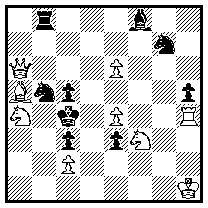 #2 (9+9) |
1.Sxc3? thr. 2.e5(A)# 1.Bxc3? thr. 2.Se5(B)# 1.Qc6! thr. 2.Qd5# |
|
(3) A. Slesarenko
3 HM Zvon Chernobylja 1992 |
|
 #2 (10+8) |
1.Qc3? thr. 2.Rxf5(A)# 1.Qc4? thr. 2.Sg6(B)# 1.Qg1! thr. 2.Qg3# Additional content (non thematic): two transferred mates. |
|
(4) A. Slesarenko
Scheme |
|
 #2 (12+9) |
1.Bd6(A)? thr. 2.Qxe5# 1.Bc5(B)? thr. 2.Rxd4# 1.cxb7! thr. 2.Qc6# |
|
(5) A. Slesarenko
Original |
|
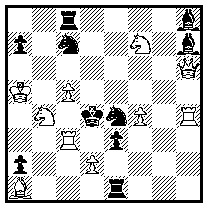 #2 (10+10) |
1.f5(A)? thr. 2.Rc1(B)# 1.Qc6! thr. 2.Sc2# Additional content (non thematic): change |
Section B: Threemovers
Judges: Israel, Russia, Serbia & Montenegro, Sweden, Ukraine
Reserve judge: Netherlands
On the 2nd move a white piece makes a non-checking move pinning a black
piece which has just made a move to the square on which it is then pinned. The
pinning must be direct, i.e. created by the move of the pinning piece itself.
At least 2 variations are required.
Example:
|
M. Marandyuk, V. Samilo
4 Pr 64-Shakhmatnoye Obozreniye 1985 |
|
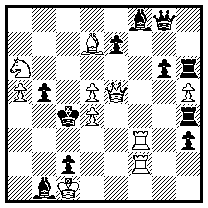 #3 (10+11) |
1.Ra3! threat 2.Bxb5+ Kxb5 3.Qe2# 1… Qxd5 2.Be6! 2… Rxd4 3.Qc7# (2… Qxe6 3.Qc5#) 1… Rxd4 2.Rf4! 2… Qxd5 3.Qe2# (2… Rxf4 3.Rc3#) (1… Re4 2.Qc7+ Kxd4 3.Rd2#, 2… Kxd5 3.Qc5#) |
Section C: Moremovers
Judges: Netherlands, Russia, Sweden, Switzerland, Ukraine
Reserve judge: France
Mate in 4 moves is required, where in the actual solution there are at
least 2 variations showing switchback of a white piece either to the square
it occupied in the diagram position or to a square it previously visited in
the course of the solution.
The key is allowed as part of the switchback mechanism (example 2). The threat
may be one of the thematic variations (examples 1 and 2).
A Rundlauf instead of a simple switchback is permitted (i.e., the thematic
piece may return to its departure square by a different route).
Examples:
|
(1) Lars Larsen
Suomen Shakki 1993 |
|
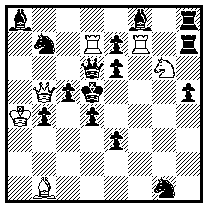 #4 (6+15) |
1.Bd3! threat 2.Qc4+ Kc6 3.Se5+ Qxe5 4.Qb5# 1…Sf3 2.Bc4+ Ke4 3.Rf4+ Qxf4 4.Bd3# 1…Sa5 2.Sf4+ Ke5 3.Qxc5+ Qxc5 4.Sg6# |
|
(2) Friedrich Chlubna
3 Pr Schach Report 1994 |
|
 #4 (7+8) |
1.Kb7! threat: 2.Bd3+ Kd5 3.e4+ B/fxe4 4.Bc4# 1…f4 2.Kc8 (3.Sg5+ Kd4 4.S7e6#) 2…f3 3.e3 (4.Sg5#) 3…Bxe3 4.d3# |
|
(3) Mikhail Marandyuk
2 Pr= Uralsky Problemist 2000 |
|
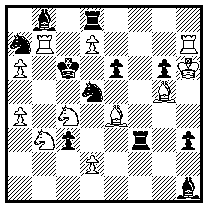 #4 (11+11) |
1.d3! threat: 2.Sd4+ Kc5 3.Sxe6+ Kc6 4.Rb6# 1…Rxd3 2.Rb6+ Kc7 3.Bf4+ Sxf4 4.Rb7# (3…e5 4.Bxe5#) 1…Rf6/Rf7 2.Sba5+ Kc5 3.Be3+ Sxe3 4.Sb3# 1…Be5 2.Sca5+ Kd6 3.Be7+ Sxe7 4.Sc4# (1…e5 2.Be7 threat: 3.S~a5# 2…Bc7 3.Sxe5+ Bxe5 4.Sa5#) |
| (4) Uri Avner 3 Pr Canadian Chess Chat 1980 |
|
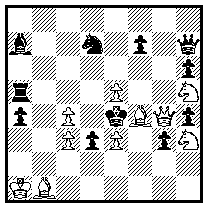 #4 (10+11) |
1.Bxg3+? Kxe3 2.Bf4+ Ke4 3.Sf2+ Bxf2! 1.Ba2! threat: 2.Bg5+ Kxe5 3.Qf4+ Ke6 4.c5# |
Section D: Studies
Judges: Belarus, Finland, Georgia, Israel, Romania
Reserve judge: Belgium
In a position in the main line of a win or draw study where an unprotected
white or black piece A is directly attacked, White or Black instantaneously
(right on the following move) places another piece B (of the same colour as
A) en-prise (again unprotected and directly attacked). This thematic move resulting
in the two white or the two black pieces A & B hanging, must be a quiet
one, i.e. not a check, nor a capture. A and B may be any pieces except pawns.
Note: in example 4, the move 4.Rb8 is not thematic. Even though two white
pieces are en-prise, the required proximity in time for this occurrence is missing.
Only 2.Rd6 is thematic.
Examples:
|
(1) G. Kasparian
1 Pr Magyar Sakkelet 1969 |
|
 Draw (4+2) |
1. Kg4! Qc8+ 2.Kf3!! (2.Kh4 Qf8!) Qb7+ 3. Rd5!! (thematic!) Q:b1 4.Ra5+ Kb7 5.Rb5+ Draw. |
|
(2) Y. Afek
3 com Schakend Nederland 1978 |
|
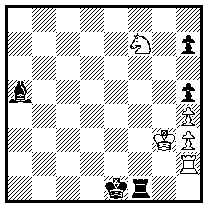 Draw (5+5) |
1. Se5! (1.Sd6? Bc7 2.Kg2 Rf8 3.Rh1+ Ke2 4.Se4 Rg8+) 1…Bc7 2. Rh1!! (thematic!) 2…R:h1 3.Kg2 Rf1 4.Sd3+ Ke2 5.Sc1+! Ke1 6.Sd3+ Ke2 7.Sc1+ Draw. |
|
(3) Y. Afek
3 Pr Hildebrand-80 2002 |
|
 Draw (5+5) |
1. B:e6! (1.b7? Sg4 -+) 1…Sg4!! (thematic!) 2. B:g4+ Ke1! 3. Bc8!! (3.B:h3? Kf1 4.b7 B:b7 -+) 3…Kf1 4.Ba6+ Kf2 5.Bb7! Kf1 6.Ba6+ Ke1 7.Bc8! Ke2 8.Ba6+ Kf2 9.Bb7! Draw. |
|
(4) P. Sobolevski
Pr Shachmati v SSSR 1951 |
|
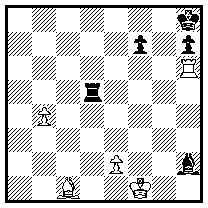 Win (5+5) |
1.Bb2+ Be5 2.Rd6! (thematic!) Rb5 3.Rd8+ Kg7 4.Rb8! (non thematic!) Rd5 5.e4! wins. |
Section E: Helpmates
Judges: Czech Republic, France, Greece, Italy, Macedonia
Reserve judge: Bulgaria
Helpmate in 3 moves. The white mating piece arrives (on the mating move)
on a square that has been vacated by a black piece during the play.
Multi-solutions and all kinds of twinning are allowed, but not Zeroposition
settings.
Restrictions:
- The black King and Pawn may not function as thematic vacating-pieces.
- A mate by a direct battery is not allowed.
Examples:
|
(1) Živko Janevski
Orbit 2000 |
|
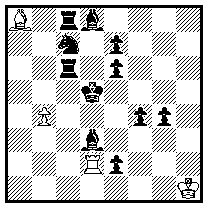 h#3 2 solutions (4+11) |
1.Kd6 b5 2.Kd7 Rxd3+ 3.Rd6 Bc6# 1.Ke4 Kg1 2.Kf3 Bxc6+ 3.Be4 Rd3# |
|
(2) Markus Ott
1 Pr Schach-Aktiv 1993 |
|
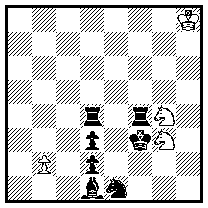 h#3 2 solutions (4+7) |
1.Ba4!! Sf2 2.Ke3 b3! 3.Sf3 Sd1# 1.Ra4!! Sf5 2.Ke2 b4! 3.Rf1 Sd4# |
Section F: Selfmates
Judges: Bulgaria, Israel, Macedonia, Poland, Ukraine
Reserve judge: Sweden
A S#3 is required, where two pieces – a white piece ‘A’ and a white or
black piece ‘B’ (B being a line-piece) – occupy (either in the initial position
or at a later stage, not necessarily at the same time) squares on the same line
‘x’. Black’s 1st and 2nd moves are made by the same piece ‘C’ which first captures
‘A’ and then withdraws, freeing line ‘x’ for ‘B’ for any purpose: movement,
control, pin, check, mate, dual avoidance etc.
There is one restriction: unacceptable as a thematic variation is the creation
of a direct black battery with ‘B’ as the rear piece and another piece ‘D’ as
the front piece, to fire and mate on the 3rd move.
Examples (taken from: "Passive Annihilation in Selfmates" by Petko
A. Petkov, StrateGems 27):
|
(1) Waldemar Tura
1 Pr Szachy 1987 |
|
 S#3 (15+9) |
1.Sa4! (2.Se6+ Kd5 3.Sc3+ Bxc3#) 1…Qxe5 2.Sd5+! Qf4 3.Sac3+ Bxc3# (2.Sh3+?, 2.Sh5+?), 1…gxf5 2.Sh3+! fxg4 3.Sf2+ Bxf2# (2.Sd5+?, 2.Sh5+?) 1…Sxg2 2.Sh5+! Sf4 3.Sg3+ Bxg3# (2.Sh3+?, 2.Sd5+?). Black captures three white Pawns (Pe5, Pf5, Pg2) and opens three white lines with dual avoidance. |
|
(2) Vladimir Zabunov
1 Pr Shach. Misal 1978 |
|
 S#3 (13+7) |
1.Ba1! (2.Rb2+ Kxe5 3.Rb4+ Bd4#), 1…Sxd6 2.Rb6+ Sc4 3.c7+ Bxb6#, 1…Sxe5 2.Re3+ Sc4 3.Bf3+ Bxe3#. Two white P-annihilations with clearance of two lines, play by the white R/Q battery and creation (with white Rook as rear battery piece) of new white P/R and B/R batteries. |
|
(3) Milan R. Vukcevich
3 Pr StrateGems 2001 |
|
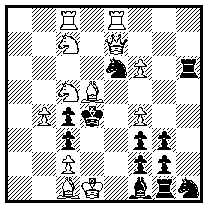 S#3 (12+12) |
1.Red8! (2.Sb3+ cxb3 3.Sb5+ Bxb5#), 1…Se6~ 2.Qe2 and 3.Qxc4+ Bxc4#, 1…Sxc7!? 2.S5e6+ Sxe6 3.Rxc4+ Bxc4#, 1…Sxc5!? 2.S7e6+ Sxe6 3.Rxc4+ Bxc4#, 1…Sxf4!? 2.Be4+ Sd5 3.Bxh6 B~#. Black Knight correction with three secondary defences as annihilation-captures on c7, c5 and f4. Umnov theme after captures by the Knight, Knight-pinning with Zugzwang after 1…Sxf4. |
|
(4) Michael Herzberg
1 Pr E. Rochada 88-89 |
|
 S#3* (11+14) |
*1…Rxd4[a] 2.Sc3+[A] Bxc3 3.Bf5+ Rxf5# (2.Sd6+?), 1…Bxd4[b] 2.Sd6+[B] Rxd6 3.Bf5+ Rxf5# (2.Sc3+?); 1.Qb6! (2.Bf5+ Kd5 3.Se3+ Rxe3#), 1…Rxd4[a] 2.Sd6+[B] Rxd6 3.Qe3+ Rxe3# (2.Sc3+?), 1…Bxd4[b] 2.Sc3+[A] Bxc3 3.Qe3+ Rxe3# (2.Sd6+?). Black self-blocks on d4 in the set and Pawn annihilation in the solution. Reciprocal change with dual avoidance, a strategy which is familiar from the orthodox threemover. |
|
(5) Waldemar Tura
2 Pr Boletim UBP 1985 |
|
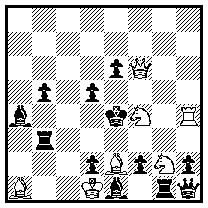 S#3 (7+12) |
1.Bd4! (2.Qxe6+ Kxd4 3.Qe3+ Rxe3#), 1…Qxg2 2.Sxe6+! Qg4 3.Qf3+ Rxf3# (2.Sh5+? Qg4 3.Sg3+ Rxg3!), 1…Rxg2 2.Sh5+! Rg4 3.Sg3+ Rbxg3# (2.Sxe6+? Rg4 3.Qf3+ Qxf3!). (1…f1S 2.Sxe6+ Bxh4 3.Qf3+ Rxf3#, 1…e5 2.Sxd5+ Kxd5 3.Se3+ Rxe3#). Dual avoidance, combined with mutual line clearance and selfpins. |
|
(6) György Bakcsi
Die Schwalbe 1983 |
|
 S#3 (14+10) |
1.g8S! (2.Sg7+ Kxe4 3.Qe3+ Rxe3#), 1…Kxe4 2.Sc5+! Kd4 3.Bxf6+ Re5#; 2…Kf5 3.Se7+ Rxe7#, 1…Kxe6 2.Sc5+! Kd6 3.Be7+ Rxe7#; 2…Kf5 3.Se7+ Rxe7#, (1…fxe6 2.Se7+ Kxe4 3.Qe3+ Rxe3#). Annihilation by the black King. |
|
(7) Petko A. Petkov
ANDA 2003 |
|
 S#3 (11+10) |
1.Ra5! (2.Bf5+ Kxd5 3.Qe4+ Bxe4#), 1…Sc5~ 2.Qa6+! ~ 3.Bf5+ Bxf5#, 1…Sxe4! 2.Rd6+ Sxd6 3.Qg6+ Bxg6#, 1…Sxd3! 2.Sf4+ Sxf4 3.Bf5+ Bxf5#. Knight correction, white line-opening after 1…Sxe4, black line-opening after 1…Sxd3 and ambush key. |
Section G: Fairies
Judges: Bulgaria, France, Japan, Slovakia, Switzerland
Reserve judge: Slovenia
Required are Anti-circe direct #2 problems showing "clash of rebirth".
A clash of rebirth may occur in the following situation:
The same square is a rebirth square for two pieces of different colours. Through
the rebirth of one of these pieces a capture by the other piece becomes illegal,
or a check is no longer effective.
The following are the permitted groups of pieces. Only one of these groups can
be exploited, and at least one piece-type belonging to the selected group must
be used.
Group 1: Grasshopper, Nightrider
Group 2: Grasshopper, Rook-hopper, Bishop-hopper
Group 3: Lion, Rook-Lion, Bishop-Lion
Group 4: Leo, Pao, Vao
Both Calvet and Cheylan Anti-circe types are permitted.
Anti-circe (definition): on making a capture, any unit (including K) is reborn
on its game-array square, as determined according to Circe rules, i.e. R, B
and S are reborn on the square of the same colour as the capture-square, pawns
on the file of the capture; fairy pieces are reborn on the promotion-square
on the file where the capture is made. The capture is legal only if the rebirth-square
is vacant. A capture may be made from a rebirth-square. The unit that is captured
is removed from the board, as in orthodox chess. A pawn capturing on its 8th
rank is not reborn as a pawn but as the piece it is promoting to; this is legal
provided the rebirth-square of the promoted unit is unoccupied. There are two
types of Anti-circe: the Calvet type where a capture on the rebirth-square
itself is legal, and the Cheylan type where it is illegal.
Examples:
|
(1) Hans-Peter Rehm
|
|
 #2 AntiCirce (9+6) Pao e3, h4, h8 Vao h1 |
1.Rb5+? 1.Bc7+? 1.Bb8! threat: 2.PAe3-e5# |
|
(2) Hubert Gockel
1 Pr HPR-60 2004 |
|
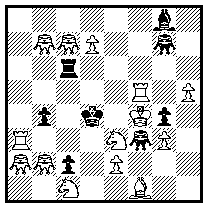 #2 AntiCirce (14+8) Grasshoppers a2,b2,b7,c7,f3,g7 |
1.Sxc2(Sb1)? [2.e3#] 1.S:g4(Sb1)! [2.e3#] |
Back to top | A – Twomovers | B
– Threemovers | C – Moremovers | D -Studies
| E – Helpmates | F – Selfmates | G
– Fairies
Invitation | Introduction
by the WCCT Subcommittee | Rules
| Questions and Answers | List
of registrations | Prior realizations of the themes
| Versions






